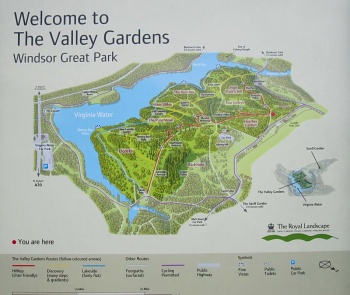
The Long Walk from Snow Hill to Windsor Castle, Windsor Great Park, July 2015
Click on image to see a larger version
Overview
Overlooked by Windsor Castle it remains one of the most important ancient lowland woodlands in the country with oaks thought to be more than 500 years old and some even older. There is also heathland with heather, birch scrub and scattered pines, and conifer plantations.
Birds
Notable Species
Virginia Water is perhaps best -known as one of the most reliable sites in the country for Mandarin Duck, they are resident here and more than a hundred can be seen at times, occasionally joined by feral Wood Duck. Great Crested Grebe, Great Cormorant and Mallard can also be seen all year joined in winter by Teal and Shoveler, Pochard and Tufted Duck.
Reed Warbler and Sedge Warbler breed in the waterside vegetation and a nearby waterfall is a regular site for Grey Wagtail.
In the woodlands all three British woodpeckers can be seen as well as Little Owl and Tawny Owl, Sparrowhawk and occasional Woodcock. Nuthatch and Treecreeper are common as are the usual species of thrush, tit and finch. Hawfinch was once present all year in small numbers but seems to have declined recently.
Warblers include Willow Warbler and Garden Warbler, Blackcap and Chiffchaff, and small numbers of Redstart are present in summer.
The conifers are home to Goldcrest, Coal Tit and Common Crossbill, and the birches may have Siskin and Lesser Redpoll. Hobby breed nearby and can often be seen chasing dragonflies and hirundines over the heathland where Nightjar, Stonechat and Woodlark breed.
In winter Hawfinch may be located, Fieldfare and Redwing are common visitors and Brambling join Chaffinch flocks feeding on beechmast.
Check-list
Birds you can see here include:
Little Grebe, Great Crested Grebe, Great Cormorant, Grey Heron, Mute Swan, Greylag Goose, Canada Goose, Common Shelduck, Egyptian Goose, Mandarin Duck, Wood Duck, Gadwall, Common Teal, Mallard, Common Pochard, Tufted Duck, Red Kite, Common Buzzard, Eurasian Sparrowhawk, Common Kestrel, Northern Hobby, Red-legged Partridge, Grey Partridge, Common Moorhen, Eurasian Coot, Eurasian Woodcock, Black-headed Gull, Common Woodpigeon, Eurasian Collared Dove, Little Owl, Tawny Owl, European Nightjar, Green Woodpecker, Great Spotted Woodpecker, Lesser Spotted Woodpecker, Woodlark, Barn Swallow, House Martin, Grey Wagtail, Pied Wagtail, Common Wren, Dunnock, Eurasian Robin, Common Redstart, European Stonechat, Eurasian Blackbird, Fieldfare, Song Thrush, Redwing, Mistle Thrush, Sedge Warbler, Common Reed Warbler, Garden Warbler, Blackcap, Common Chiffchaff, Willow Warbler, Goldcrest, Spotted Flycatcher, Long-tailed Tit, Marsh Tit, Coal Tit, Blue Tit, Great Tit, Eurasian Nuthatch, Common Treecreeper, Common Jay, Common Magpie, Carrion Crow, Eurasian Jackdaw, Common Starling, House Sparrow, Chaffinch, Brambling, European Greenfinch, European Goldfinch, Eurasian Siskin, Lesser Redpoll, Common Crossbill, Common Bullfinch, Hawfinch
Other Wildlife
Grey Squirrel Sciurus carolinensis is the most commonly seen mammal but deer are present in good numbers and include Red Deer Cervus elaphus, Fallow Deer Cervus dama and Roe Deer Capreolus capreolus, as well as the introduced Muntjac Muntiacus reevesi.
Insects are well-represented with more than 30 species recorded including Painted Lady Vanessa cardui, Purple Emperor Apatura iris, White Admiral Limenitis camilla, Grayling Hipparchia semele and Silver-studded Blue Plebejus argus and Holly Blue Celastrina argiolus as well as five species of skipper. Like other areas of ancient woodland the insect fauna, and particularly beetles, associated with decaying wood is incredibly rich. More than 2000 beetle species have been recorded here making it one of the best sites in the country for entomologists alongside the New Forest.
There are also rare species of Diptera (flies) including Chrysopilus lactus and Rainieria calceata, not known from any other British site and several species of damselfly and dragonfly of interest. Damselflies found here include the Scarce Blue-tailed Ischnura pumilio, rare outside south-western Britain, and the more common Southern Coenagrion mercuriale and Small Red Ceriagrion tenellum Damselflies.
Similarly, the list of fungi species recorded here is long and varied.

Map of the Valley Gardens and Virginia Water section of Windsor Great Park
Click on image to see a larger version
Site Information
History and Use
About 18 miles (30km) to the west of London lies Windsor Great Park, like the New Forest an area set aside by the Norman kings as a hunting preserve.
Areas of Interest
Virginia Water is a large ornamental lake at the southern end of the park and a walk around it provides easy access to a good range of waterbirds and birds of the surrounding woodlands. Map
Access and Facilities
Windsor Great Park lies immediately south of the town of Windsor and to explore this area, park in the large carpark just north of the Wheatsheaf Hotel on the A30 near the junction with the B369.
The gates at the rear of the carpark lead through woodland to Virginia Water, and a walk of about 5 miles (8km) can be taken around the lake, past the waterfall and through superb ancient woodland especially on the southern side of the lake.
There are many tracks leading off northwards into the parkland or there are other carparks in the north of the park.
External Links
Content and images originally posted by Steve




